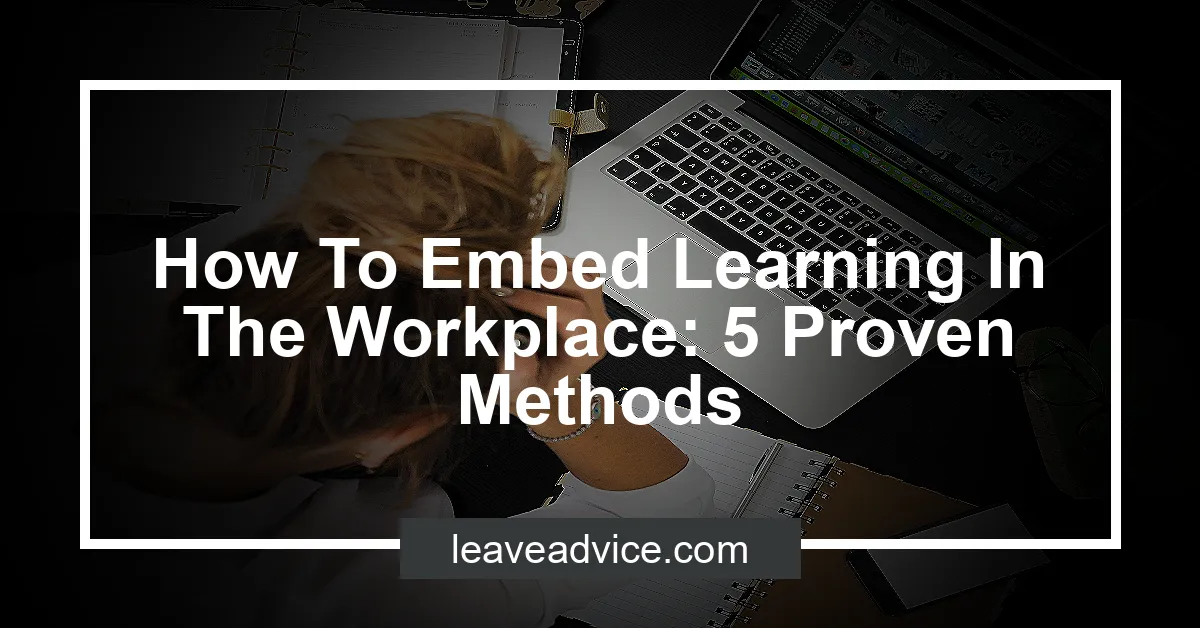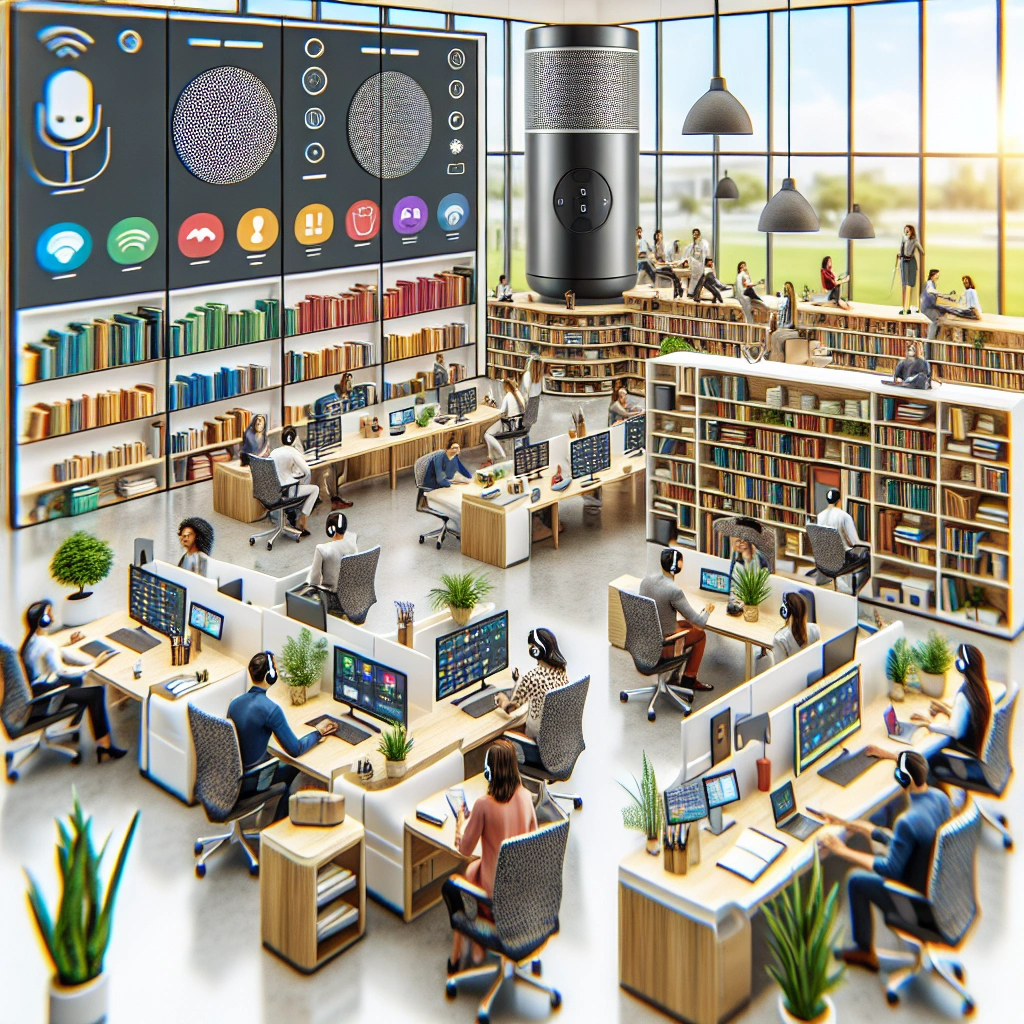How To Embed Learning In The Workplace: 5 Proven Methods


Workplace learning can be defined as the process of acquiring knowledge and skills within a work environment. Embedding learning in the workplace is important because it provides employees with continuous opportunities to learn and develop new skills, ultimately keeping them engaged and productive.
Research has shown that embedding a learning culture within an organization offers employees an outlet to be creative and develop new skills, thus keeping them engaged with their current and future roles.
To embed learning into your organization, you can create diverse learning opportunities, provide effective online training, use technology to engage teams in learning opportunities, and integrate skills learning into your employees’ workflows.
Check out this Youtube video: Learn how to embed learning in the workplace and create a culture of continuous improvement with valuable tips and insights.
The Benefits of Embedding Learning in the Workplace
Improved employee satisfaction
Improved employee satisfaction is a direct result of embedding learning in the workplace. When employees have the opportunity to learn and grow within their roles, they feel more valued and fulfilled. This leads to increased job satisfaction, motivation, and a positive work environment. For example, providing regular workshops and skill development programs can greatly enhance job satisfaction as employees feel invested in.
Enhanced employee engagement and retention
Enhanced employee engagement and retention are critical benefits of integrating learning in the workplace. Employees feel more engaged when they have opportunities for continuous learning and skill development, leading to higher retention rates. For instance, implementing mentorship programs and career development initiatives can significantly boost employee engagement and retention, resulting in a more committed and loyal workforce.
| Factor | Impact |
|---|---|
| Skill Development | Boosts job satisfaction and provides a sense of personal growth |
| Continuous Learning | Fosters a culture of engagement and loyalty, leading to higher retention rates |
Embedding learning in the workplace not only improves employee satisfaction but also enhances engagement and retention, thereby contributing to a more productive and resilient workforce.
Creating a Learning Culture in the Workplace
Promoting continuous learning
By encouraging continuous learning, employees stay up-to-date with industry trends and best practices, leading to greater confidence and increased productivity. Providing access to online courses, workshops, and seminars can foster a culture of ongoing learning and innovation within the organization.
Providing opportunities for skill development
Offering on-the-job training projects and developmental assignments allows employees to gain new skills, knowledge, and competencies necessary for career advancement. From onboarding to ongoing education, prioritizing professional development through virtual learning and mentorship programs can enhance employee skill sets.
| Benefits of Promoting Continuous Learning | Opportunities for Skill Development |
|---|---|
| – Up-to-date industry knowledge | – On-the-job training projects and developmental assignments to acquire new skills |
| – Increased confidence and productivity | – Virtual learning and mentorship programs for ongoing skill enhancement |
| – Fostered culture of innovation | – Enhance skill sets through onboarding and ongoing education |
| – Improved employee retention and satisfaction | – Facilitate career advancement through skill development initiatives |
Identifying Learning Needs in the Workplace
Conducting training needs assessments
| Methods for Assessing Training Needs |
|---|
| HR records, individual interviews, focus groups, surveys, questionnaires, self-assessments, and observations |
Utilizing employee feedback
Listening to employee feedback and making it transparent fosters a culture of continuous improvement. Effective feedback not only enhances individual performance but also contributes to the overall success of the team.
Feedback communication, when done proficiently, propels skill enhancement and operational efficiency. Additionally, it ensures that organizational standards are met and aligns with the business priorities.
Some factors to consider when leveraging employee feedback include urgency, impact, frequency, and alignment with learning needs. Understanding these factors can aid in strategically addressing crucial performance gaps and skill requirements.
Identifying learning needs in the workplace requires a comprehensive approach, including a thorough training needs assessment and effective utilization of employee feedback. This process ensures that the organization is equipped with the right skills and capabilities to drive success.
Implementing On-The-Job Learning Opportunities
Job shadowing and mentorship programs
Implementing job shadowing and mentorship programs is crucial for embedding learning in the workplace. Job shadowing allows employees to gain new skills by observing and learning from experienced colleagues.
This provides a hands-on understanding of tasks and responsibilities that goes beyond theoretical knowledge. Mentorship programs, on the other hand, pair less experienced employees with seasoned professionals to facilitate skill transfer and knowledge exchange.
These opportunities create a culture of continuous learning and growth within the organization.
Learning through real-life experiences
Encouraging learning through real-life experiences is essential for employee development. By providing opportunities for experiential learning, employees can directly apply their skills in practical scenarios.
This enhances retention of new knowledge and skills and fosters a deeper understanding of their roles. Real-life experiences such as internships, apprenticeships, and management training allow employees to learn in a hands-on environment, promoting innovation and creativity in problem-solving.
Utilizing Technology for Learning
Implementing online learning platforms has become essential in today’s workplace to facilitate continuous learning and skill development. With the rise of remote work, companies are leveraging platforms like Coursera, Udemy, and LinkedIn Learning to provide employees with access to a wide range of courses and training modules.
These platforms offer flexibility and convenience, allowing employees to learn at their own pace, thereby embedding learning seamlessly into their daily work routine.
Encouraging the use of educational apps and tools further enhances the learning experience for employees. Utilizing apps like Khan Academy, BrainPOP, and Quizlet fosters a more interactive and engaging learning environment.
Additionally, leveraging collaborative tools such as Google Classroom and virtual reality technologies can create a dynamic and immersive learning experience, enhancing knowledge retention and application in the workplace.
| Online Learning Platforms | Educational Apps and Tools |
|---|---|
| Coursera | Khan Academy |
| Udemy | BrainPOP |
| LinkedIn Learning | Quizlet |
By embracing these technological advancements, organizations can effectively embed learning in the workplace, ensuring continuous growth and development for their employees.
Building Learning Communities in the Workplace
Establishing peer learning networks
To establish peer learning networks in the workplace, it’s crucial to create a culture of collaboration and knowledge sharing. Encourage employees to connect and learn from each other by organizing informal mentorship programs where experienced employees can guide and support new hires.
Additionally, implementing peer learning platforms or forums can provide a digital space for employees to ask questions, seek advice, and share expertise, fostering a sense of community and mutual growth.
Organizing regular knowledge-sharing sessions
Organizing regular knowledge-sharing sessions can significantly impact embedding learning in the workplace. Host lunch and learn sessions, workshops, or team presentations where employees can showcase their expertise or share insights from recent projects.
These sessions not only help in disseminating knowledge but also promote engagement, collaboration, and a continuous learning mindset throughout the organization. Providing a structured format for employees to share their knowledge and experiences can strengthen the overall learning culture within the workplace.
Encouraging Leadership Support for Learning
As a seasoned HR professional, I’ve seen firsthand the transformative power of fostering a culture of learning from the top down. When leadership actively supports and engages in learning initiatives, it sets the tone for the entire organization.
Imagine a ship where the captain is genuinely excited about exploring new territories. It’s contagious!
This approach encourages employees to take the helm of their own learning journey, knowing their leaders have their backs. Leaders embracing and championing learning not only fosters a culture where growth and development are celebrated but also demonstrates to employees that continual learning is not only encouraged but also expected.
This creates a workplace environment that thrives on innovation and adaptability.
Fostering a culture of learning from the top down
Leaders can foster a culture of learning from the top down by actively participating in learning opportunities themselves. When employees see their leaders engaging in professional development and openly sharing their learnings, it creates an environment where continuous growth is ingrained in the organization’s DNA.
Additionally, leaders must align learning initiatives with the organization’s strategic objectives. By highlighting how learning contributes to achieving broader business goals, leaders can magnify the importance of learning at all levels.
When leaders embody the value of continuous learning, they become influential role models, inspiring others to follow suit and creating a ripple effect throughout the organization.
Providing resources for leadership development programs
For leadership development programs to thrive, resources need to be easily accessible and robust. Effective support encompasses providing not only financial resources but also time.
Leaders need dedicated time to engage in development programs without the fear of falling behind in their day-to-day duties. Furthermore, resources should include mentorship opportunities, coaching, and access to tailored learning experiences.
Remember, leadership is not just about telling but showing. Therefore, providing resources for leadership development programs is an investment that pays back tenfold in the form of a well-equipped, forward-thinking leadership team.
This, in turn, cultivates an environment where everyone is committed to continuous learning in pursuit of excellence.
Measuring and Evaluating Learning Effectiveness
To effectively measure the learning progress in the workplace, it’s essential to utilize key performance indicators (KPIs) tailored to learning and development. KPIs such as training attendance rate, retention of new skills and knowledge, business performance/productivity metrics, course net promoter score, stakeholder perception, and participant satisfaction can provide valuable insights into the effectiveness of learning initiatives.
By tracking these KPIs, organizations can gauge the impact of their training programs and make data-driven decisions to optimize learning outcomes.
When it comes to collecting feedback and conducting follow-up assessments, it’s crucial to gather meaningful feedback that goes beyond mere participation statistics. Employing research-based tips for gathering and providing feedback, such as assessing skill alongside knowledge through pre- and post-training assessments, can offer a comprehensive understanding of the effectiveness of learning programs.
Additionally, establishing measurable training objectives aligned with organizational needs and specific skills, followed by conducting pretests and posttests to compare results, allows for a thorough evaluation of learning effectiveness.
By leveraging targeted KPIs and implementing robust feedback mechanisms, organizations can accurately measure and evaluate the effectiveness of learning in the workplace, ensuring continuous improvement and enhanced employee development.
Overcoming Challenges in Embedding Learning in the Workplace
Addressing resistance to change
To address resistance to change in the workplace, it is crucial to communicate change effectively. This involves explicitly informing employees about the upcoming changes and the reasons behind them.
Additionally, listening to employees’ concerns and providing them with opportunities to offer input can help minimize resistance. Educating employees on the value of the changes can also make them more receptive.
Dealing with time and resource constraints
When facing time and resource constraints, it’s important to identify and resolve them effectively. Clearly defining the project scope and estimating time and costs more accurately can help in tackling resource constraints.
To overcome time constraints, providing access to the right tools and experimenting with different learning formats can facilitate embedding learning in the flow of work.
Leveraging External Learning Resources
Partnering with educational institutions is a phenomenal way to embed learning in the workplace. By collaborating with universities and colleges, organizations can gain access to cutting-edge research, fresh perspectives, and talented future professionals.
These partnerships can also lead to innovative internship programs, allowing students to gain valuable real-world experience while contributing to the organization’s growth.
Moreover, accessing industry-specific workshops and seminars can significantly enhance the learning experience for employees. These workshops provide practical, hands-on training tailored to the specific needs of the industry, ensuring that employees stay updated with the latest trends and developments.
Additionally, such events promote networking opportunities, allowing employees to connect with industry experts and gain valuable insights that can be directly applied to their roles.
| Partnerships with educational institutions | Accessing industry-specific workshops and seminars |
|---|---|
| Gain access to cutting-edge research and fresh perspectives | Obtain practical, hands-on industry training |
| Foster innovative internship programs | Stay updated with the latest industry trends and developments |
| Cultivate a talent pool from universities and colleges | Facilitate networking opportunities with industry experts |
Adaptability and Flexibility in Learning Approaches
Understanding different learning styles
Understanding different learning styles is crucial in creating an inclusive learning environment. It involves recognizing that individuals have unique ways of processing information, such as visual, auditory, and kinesthetic learners.
For instance, incorporating visual aids like diagrams and charts caters to visual learners, while group discussions engage auditory learners. Recognizing and embracing these diverse styles allows for a more comprehensive approach to knowledge dissemination.
Incorporating personalized learning paths
Incorporating personalized learning paths allows individuals to take ownership of their educational journey. By tailoring instruction to meet the unique needs of each learner, educators can foster a deeper understanding of the material.
This approach enhances motivation, commitment, and engagement, leading to improved learning outcomes. Customized learning paths empower students to make meaningful connections with the material, promoting a sense of achievement and fulfillment in their educational pursuits.
Supporting Employee-Led Learning Initiatives
Allowing time for personal development projects
One way to embed learning in the workplace is by allowing employees to dedicate a portion of their work hours to personal development projects. This could involve learning new skills, exploring innovative ideas, or even pursuing passion projects that align with the company’s goals.
By providing dedicated time for such initiatives, employees feel valued and empowered to invest in their continuous improvement, ultimately benefiting the organization as a whole.
Recognizing and rewarding self-directed learning efforts
Another effective strategy is recognizing and rewarding employees who take the initiative to engage in self-directed learning. This could be through praise in team meetings, acknowledging their efforts in internal communications, or even instituting a rewards program for significant self-improvement milestones.
By doing so, the organization not only motivates the employees but also fosters a culture that encourages continuous learning and skill enhancement.
Creating a Learning-Focused Physical Workspace
Collaboration zones, equipped with modern technology and comfortable furniture, are crucial for fostering teamwork and knowledge-sharing. These spaces should offer privacy when needed and encourage open discussions for innovative idea exchange.
Additionally, incorporating flexible meeting areas promotes spontaneous interactions, leading to effective collaboration and cross-functional learning opportunities.
Designing spaces for collaboration and knowledge-sharing
A successful collaboration space integrates various seating options, like couches, standing desks, and small meeting pods, facilitating different interaction styles. Incorporating writable walls and digital screens encourages brainstorming, creative problem-solving, and knowledge-sharing sessions.
Additionally, including comfortable breakout areas encourages informal discussions and peer learning, fostering a culture of shared knowledge and collaboration.
Incorporating learning resources into the work environment
Embedding learning resources in the physical work environment involves creating central hubs with access to digital learning platforms, e-books, and educational materials. Furthermore, integrating interactive learning kiosks and digital libraries within the workspace provides convenient access to diverse learning resources.
Employers can also arrange regular knowledge-sharing events, workshops, and seminars to empower employees and build a continuous learning culture.
| Designing for Collaboration and Knowledge-Sharing | Incorporating Learning Resources |
|---|---|
| – Various seating options for different interactions | – Central hubs with access to digital learning platforms |
| – Writeable walls and digital screens for brainstorming | – Interactive learning kiosks and digital libraries |
| – Comfortable breakout areas for informal discussions | – Regular knowledge-sharing events and workshops |
Fostering a Culture of Continuous Improvement
Embracing a growth mindset
Promoting a growth mindset within the workplace involves cultivating a belief in the ability to develop and improve one’s skills and knowledge through dedication and continuous learning. This can be achieved through regular communication emphasizing the value of taking on challenges and embracing opportunities for growth.
Encouraging experimentation and learning from failures
Fostering a culture of experimentation involves creating an environment where employees feel safe to try new things and make mistakes without fear of repercussions. Encouraging learning from failures requires a sophisticated understanding of failure’s causes and contexts to avoid blaming, while focusing on effective strategies for improvement.
Recommended Amazon Products for Embedding Learning in the Workplace
Here’s a curated list of products that can help you embed learning in the workplace with ease. These recommendations are based on functionality, price, and reviews.
Product Name: Echo Dot (3rd Gen) – Smart speaker with Alexa
The Echo Dot is a versatile smart speaker with Alexa, perfect for creating a learning-focused physical workspace. It can be used for accessing educational content, setting reminders for learning activities, and promoting a culture of continuous improvement. With its affordable price and high customer ratings, the Echo Dot is an excellent addition to any learning environment.
Find the Echo Dot (3rd Gen) on Amazon


Product Name: Moleskine Classic Notebook
The Moleskine Classic Notebook is an essential tool for fostering a culture of continuous improvement and encouraging employee-led learning initiatives. Its high-quality paper and durable design make it suitable for note-taking, reflection, and personal development projects. This notebook is highly regarded for its functionality and is a popular choice among professionals for documenting learning experiences.
Find the Moleskine Classic Notebook on Amazon


Product Name: Bose QuietComfort 35 II Wireless Bluetooth Headphones
The Bose QuietComfort 35 II headphones are a valuable resource for creating a learning-focused physical workspace and overcoming challenges in embedding learning in the workplace. With their industry-leading noise-cancellation technology, these headphones provide an immersive learning experience, ideal for online learning platforms and educational apps. Highly praised for their comfort and sound quality, they offer an exceptional learning environment.
Find the Bose QuietComfort 35 II on Amazon


Product Name: Learning Resources Prison Break
The Learning Resources Prison Break game is an innovative way to promote leadership support for learning and encourage adaptability and flexibility in learning approaches. This interactive game fosters problem-solving skills, teamwork, and adaptability, making it an engaging learning tool for workplace training. It has received positive reviews for its educational value and ability to inspire continuous improvement.
Find the Learning Resources Prison Break on Amazon


Product Name: Fujitsu ScanSnap iX1500 Color Duplex Document Scanner
The Fujitsu ScanSnap iX1500 is a powerful tool for identifying learning needs in the workplace and implementing on-the-job learning opportunities. It enables the digitization of documents, training materials, and real-life experiences, facilitating knowledge-sharing and mentorship programs. With its efficient scanning capabilities and user-friendly interface, it supports the measurement and evaluation of learning effectiveness.
Find the Fujitsu ScanSnap iX1500 on Amazon


Top Recommended Product for Embedding Learning in the Workplace
If you’re looking for the best solution for embedding learning in the workplace, we highly recommend the Echo Dot (3rd Gen) – Smart speaker with Alexa. This versatile smart speaker provides continuous access to educational content, supports a culture of continuous improvement, and fosters a learning-focused physical workspace.
It has a high customer rating and offers excellent functionality at an affordable price.
Ready to improve embedding learning in your workplace? Check out the Echo Dot (3rd Gen) today for the best results!


Conclusion
Embedding learning in the workplace is crucial for the growth and development of employees. It provides them with the opportunity to acquire new skills, knowledge, and competencies that can contribute to individual and organizational success.
By investing in employee learning and development, organizations can create a culture of continuous improvement and innovation, leading to a more competitive and adaptable workforce.
Furthermore, the importance of embedding learning in the workplace cannot be overstated when it comes to organizational success. Continuous learning enables employees to stay updated with the latest industry trends, technologies, and best practices, ultimately enhancing their performance and productivity.
It also fosters a culture of creativity, collaboration, and problem-solving, which are essential for driving business growth and achieving long-term success.
Continuous learning not only benefits employees in their professional growth but also contributes to the overall success of the organization. By prioritizing learning and development in the workplace, companies can attract and retain top talent, adapt to industry changes, and maintain a competitive edge in the market.
Thus, embedding learning in the workplace is an indispensable strategy for achieving sustainable growth and success in today’s dynamic business environment.

















